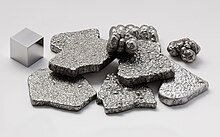
Back Metaal Afrikaans Metalle ALS Metal AN Alata ANN فلز Arabic فيليز ARY معدن ARZ ধাতু Assamese Metal AST Metal Azerbaijani


| Part of a series on the |
| Periodic table |
|---|
A metal (from Ancient Greek μέταλλον (métallon) 'mine, quarry, metal') is a material that, when polished or fractured, shows a lustrous appearance, and conducts electricity and heat relatively well. These properties are all associated with having electrons available at the Fermi level, as against nonmetallic materials which do not.[1]: Chpt 8 & 19 [2]: Chpt 7 & 8 Metals are typically ductile (can be drawn into wires) and malleable (they can be hammered into thin sheets).[3]
A metal may be a chemical element such as iron; an alloy such as stainless steel; or a molecular compound such as polymeric sulfur nitride.[4] The general science of metals is called metallurgy, a subtopic of materials science; aspects of the electronic and thermal properties are also within the scope of condensed matter physics and solid-state chemistry, it is a multidisciplinary topic. In colloquial use materials such as steel alloys are referred to as metals, while others such as polymers, wood or ceramics are nonmetallic materials.
A metal conducts electricity at a temperature of absolute zero,[5] which is a consequence of delocalized states at the Fermi energy.[1][2] Many elements and compounds become metallic under high pressures, for example, iodine gradually becomes a metal at a pressure of between 40 and 170 thousand times atmospheric pressure. Sodium becomes a nonmetal at pressure of just under two million times atmospheric pressure, and at even higher pressures it is expected to become a metal again.
When discussing the periodic table and some chemical properties the term metal is often used to denote those elements which in pure form and at standard conditions are metals in the sense of electrical conduction mentioned above. The related term metallic may also be used for types of dopant atoms or alloying elements.
In astronomy metal refers to all chemical elements in a star that are heavier than helium. In this sense the first four "metals" collecting in stellar cores through nucleosynthesis are carbon, nitrogen, oxygen, and neon. A star fuses lighter atoms, mostly hydrogen and helium, into heavier atoms over its lifetime. The metallicity of an astronomical object is the proportion of its matter made up of the heavier chemical elements.[6][7]
The strength and resilience of some metals has led to their frequent use in, for example, high-rise building and bridge construction, as well as most vehicles, many home appliances, tools, pipes, and railroad tracks. Precious metals were historically used as coinage, but in the modern era, coinage metals have extended to at least 23 of the chemical elements.[8] There is also extensive use of multi-element metals such as titanium nitride[9] or degenerate semiconductors in the semiconductor industry.
The history of refined metals is thought to begin with the use of copper about 11,000 years ago. Gold, silver, iron (as meteoric iron), lead, and brass were likewise in use before the first known appearance of bronze in the fifth millennium BCE. Subsequent developments include the production of early forms of steel; the discovery of sodium—the first light metal—in 1809; the rise of modern alloy steels; and, since the end of World War II, the development of more sophisticated alloys.
- ^ a b Kittel, Charles (2018). Introduction to solid state physics. Paul McEuen (Global edition, [9th edition] ed.). Hoboken, NJ: Wiley. ISBN 978-1-119-45416-8.
- ^ a b Ashcroft, Neil W.; Mermin, N. David (1976). Solid state physics. New York: Holt, Rinehart and Winston. ISBN 978-0-03-083993-1.
- ^ Callister, William D. (1997). Materials science and engineering: an introduction (4th ed.). New York: John Wiley & Sons. ISBN 978-0-471-13459-6.
- ^ Chiang, CK (1977). "Transport and optical properties of polythiazyl bromides: (SNBr0.4)x". Solid State Communications. 23 (9): 607–612. Bibcode:1977SSCom..23..607C. doi:10.1016/0038-1098(77)90530-0.; Greenwood, NN; Earnshaw, A (1998). Chemistry of the Elements. Oxford: Butterworth-Heinemann. p. 727. ISBN 978-0-7506-3365-9.; Mutlu, H; Theato, P (2021). "Polymers with sulfur-nitrogen bonds". In Zhang, X; Theato, P (eds.). Sulfur-Containing Polymers: From Synthesis to Functional Materials. Weinheim: Wiley-VCH. pp. 191–234 (191). ISBN 978-3-527-34670-7.
- ^ Yonezawa, F. (2017). Physics of Metal-Nonmetal Transitions. Amsterdam: IOS Press. p. 257. ISBN 978-1-61499-786-3.
Sir Nevill Mott (1905–1996) wrote a letter to a fellow physicist, Prof. Peter P. Edwards, in which he notes... I've thought a lot about 'What is a metal?' and I think one can only answer the question at T = 0 (the absolute zero of temperature). There a metal conducts and a nonmetal doesn't.
- ^ Martin, John C. "What we learn from a star's metal content". John C. Martin's Homepage. Retrieved March 25, 2021.
- ^ Martin, John C.; Morrison, Heather L. (May 18, 1998) [1998]. "A New Analysis of RR Lyrae Kinematics in the Solar Neighborhood". The Astronomical Journal. 116 (4) (published October 1, 1998): 1724–1735. arXiv:astro-ph/9806258. Bibcode:1998AJ....116.1724M. doi:10.1086/300568. S2CID 18530430 – via IOPscience.
- ^ Roe, J.; Roe, M. (1992). "World's coinage uses 24 chemical elements". World Coinage News. 19 (4, 5): 24–25, 18–19.
- ^ Stampfl, C.; Mannstadt, W.; Asahi, R.; Freeman, A. J. (2001). "Electronic structure and physical properties of early transition metal mononitrides: Density-functional theory LDA, GGA, and screened-exchange LDA FLAPW calculations". Physical Review B. 63 (15): 155106. Bibcode:2001PhRvB..63o5106S. doi:10.1103/PhysRevB.63.155106.